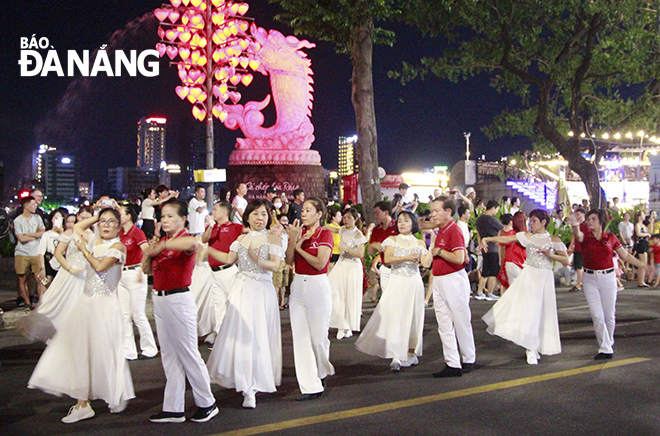Positive outcomes from cultural village movement
The movement aimed at developing cultural villages and neighbourhoods across the city has grown steadily, influencing residents' lifestyles profoundly. This initiative has transformed villages and neighbourhoods into cleaner, greener, and more beautiful areas, fostering a strong sense of community and creating a healthy, civilised cultural environment at the grassroots level.
 |
| The movement to build cultural villages and residential areas has had a significant impact on preserving and promoting traditional cultural values and positive customs at the grassroots level. Photo: X.D. |
Enhancing local cultural life
For five consecutive years (2019-2023), Residential Area No. 62 in An Khe Ward, Thanh Khe District, has been recognised as a cultural neighbourhood, showcasing exemplary efforts in promoting this city-wide movement. Residents unite and support local activities enthusiastically, participating in impactful projects like " Residential Areas Free from Waste", and "Safe, Civilised, and Clean Roads". These initiatives enhance the neighbourhood's appearance and improve residents' living conditions.
Mr. Ho Thanh Long from Residential Area No. 62 shared that the area sets clear objectives for maintaining the “Cultural Family” and “Cultural Residential Area” standards at the beginning of each year. This includes pledges for fire safety and environmental cleanliness. Community initiatives such as education support, poverty reduction, and the fight against social evils receive significant participation. “This movement has changed residents’ perspectives and daily practices. It encourages mutual support and collaborative efforts towards the local economic and social development goals,” said Mr Long.
In Hoa Vang District, the cultural village movement has played a key role in achieving national targets for new rural development. The success of this initiative has brought notable changes, including rapid infrastructure improvements and productive economic models that uplift both material and spiritual living standards. The movement has also helped preserve and promote traditional cultural values and positive practices. Rituals, traditional festivals, and folk games have been revitalised to suit contemporary times
According to Mr. Tan Kim, Head of the Front Work Committee of Bo Ban Village, Hoa Phong Commune, the sense of community has always been cherished in the village. The residents have collectively established guidelines outlining communal norms and expectations. They also collaborate in farming activities, sharing insights and supporting one another in animal husbandry and crop cultivation. Such efforts have strengthened neighbourly ties and preserved traditional customs, passing them down to younger generations.
 |
| The movement has also contributed to improving both the material and spiritual life of the people. Photo: X.D. |
Widespread influence of movement
The movement has gained broad support from residents, with all residential areas and villages registering to achieve cultural status in 2023. From modest beginnings, 2,471 out of 2,911 residential areas and villages have now attained cultural recognition, accounting for 84.9% — a significant increase from 2000.
According to Mr. Ha Vy, Deputy Director of the Department of Culture and Sports, building cultural villages and residential areas is a continuous process. The focus should be on implementing innovative approaches to improve the quality of the movement and adapt it to local conditions. Effective communication is essential to broaden the reach and impact of the movement, fostering noticeable change at the grassroots level. Additionally, urban planning, crime prevention, and adherence to community norms must be enhanced to promote lawful and respectful living within the community. Successful models should be reviewed and replicated to align with current needs.
Ms. Nguyen Thi Anh Thi, Deputy Chair of the City People’s Committee, stated that compliance with laws and active participation in the movement have significantly contributed to community order and security. Many cultural and sports facilities have been built with local government and community support, including street lighting, gateways, cultural houses, sports fields, and inter-village roads. These improvements have not only enhanced the landscape but also created spaces for cultural, sports, and community activities, enriching residents' cultural and spiritual lives.
Moving forward, the dedication and unity of local authorities and residents, combined with the enthusiasm of community leaders, will ensure continued success in developing cultural villages and residential areas, contributing to the overall progress of Da Nang.
|
Criteria and recognition guidelines The Da Nang People's Committee recently issued new guidelines, effective from January 1, 2025, detailing the criteria and processes for awarding the titles of “Cultural Family” and “Cultural Village/ Residential areas”. Villages and residential areas must score at least 85 points and meet specific conditions outlined in the government’s Decree 86/2023/ND-CP. Evaluation criteria include economic stability and development (up to 10 points); vibrant cultural and spiritual life (up to 22 points); a safe, friendly, clean environment (up to 23 points); adherence to government policies and laws (up to 25 points); community solidarity and mutual assistance (up to 10 points); and an additional 10 points for special achievements. |
Reporting by K.NGUYEN - Translating by TRUC VY








